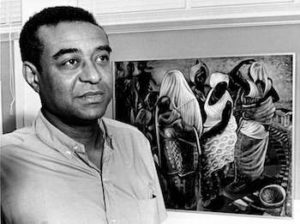
John Biggers
On this date in 1924, John Biggers was born. He was a Black artist.
From Gastonia, North Carolina, he was born in a shotgun house built by his father, Paul. His father was a Baptist preacher, schoolteacher, farmer, principal of a three-room school, and shoemaker. His mother, Cora, did laundry and cooked for white families. Biggers was the youngest of seven in a tightly-knit family that valued education and creative endeavors.
In 1937, after her husband died, Cora Biggers took a position as a matron in an orphanage for Black children. She sent John and his brother Joe to Lincoln Academy. After graduation from Lincoln, Biggers entered Hampton Institute, planning to study the practical trade of plumbing (he included boiler room drawings with his application).
During his first year there, he enrolled in an art class taught by art educator Viktor Lowenfeld, a white Jewish refugee from Austria who had been forced to leave his country in 1939 because of Nazi persecution. No stranger to racial prejudice, Lowenfeld was concerned with altering his students' perceptions toward their African heritage by investigating the social and religious context of African art. Lowenfeld encouraged his students to learn about the art and culture of their heritage and introduced them to African sculpture and works by other African American artists. The Hampton Museum had a significant collection of African art, objects, and artifacts, and the college was one of the first institutions in the country to collect such work.
While at Hampton, Biggers was introduced to the art of the American Regionalists Grant Wood, Thomas Hart Benton, Reginald Marsh, and Harry Sternberg, and the Mexican muralists Diego Rivera, David Alfaro Siqueiros, and Jose Clemente Orozco. He also was influenced by figures prominent in the Harlem Renaissance, including writers W. E. B. Du Bois and Alain Locke, and artists William Artis, Hale Woodruff, Elizabeth Catlett, and Charles White became a mentor to Biggers. In 1943 he was drafted into a segregated navy. Discharged in 1945, he returned to Hampton and followed Lowenfeld to Pennsylvania State University. In 1948 Biggers received B.S. and M.S. degrees and married Hazel Hales.
A year later, he moved to Houston, where he became the founding chairman of the art department at Texas Southern University, then called Texas State University for Negroes. He held that position for thirty-four years. Biggers initiated a mural program for art majors in which every senior student was expected to complete a mural on campus. There are now 114 such murals on the Texas Southern campus. In 1957 Biggers was one of the first American Black artists to visit Africa to study African traditions and culture. With the help of a grant from UNESCO, he and his wife traveled for six months in Ghana, Benin (then called Dahomey), Nigeria, and Togo in West Africa. The experience transformed his life and work.
On his return, Biggers created a visual diary of his travels, Ananse: The Web of Life in Africa 1962. Dr. John Thomas Biggers is widely acclaimed for his complex, symbolic murals based on African American and African cultural themes. Few artists have been outstanding practicing artists and effective educators, yet Biggers successfully maintained his dual careers until his 1983 retirement. He was honored by a major retrospective of his work that traveled to seven art museums across the United States, including The Museum of Fine Arts, Houston; the Cincinnati Art Museum; Hampton University Museum; North Carolina Museum of Art; Wadsworth Athenaeum; Museum of Fine Arts, Boston; and the California Afro-American Museum.
Before his retirement in 1983, Biggers left a fifty-foot mural in the student center for Texas Southern University. The mural depicts the progression of birth, death, and the continuity of heritage. John Bigger died in February 2001.
The St. James Guide to Black Artist
Edited by Thomas Riggs
Copyright 1997, St. James Press, Detroit, MI
ISBN 1-55862-220-9
